Nanoparticle Linear Film Polarizer
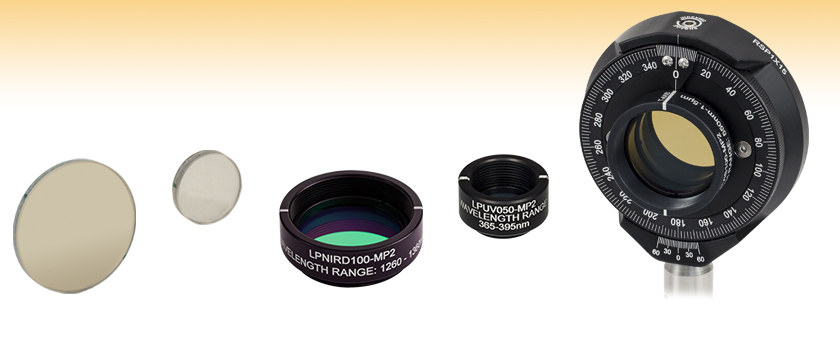
- UV, Visible, NIR, and IR Spectral Ranges
- Unmounted and Mounted Versions
- Extinction Ratios Up to 100 000:1
- Laser Damage Thresholds Up to 25 W/cm2
Unmounted Linear Polarizers
LPVIS100
(Ø25.0 mm)
LPUV050
(Ø12.5 mm)
LPUV050-MP2
(SM05 Compatible)
LPNIRD100-MP2
(SM1 Compatible)
Mounted Linear
Polarizer in
RSP1X15 Indexed
Rotation Mount
Mounted Linear Polarizers

Please Wait
Features
- High Extinction Ratio and Laser Damage Threshold (See Tables Below)
- Four Polarizer Sizes
- Item # Prefix LPUV, LPVISA, LPVISC, LPVIS, LPNIR, LPNIRA, LPNIRD, LPNIRF, and LPMIR: Ø12.5 mm or Ø25.0 mm
- Item # Prefix LPNIRB and LPNIRC: Ø1/2" or Ø1"
- Unmounted or Mounted in SM-Threaded Housing
- Item # Prefixes LPNIRB, LPNIRC, LPNIRD, and LPNIRF Have Flat Spectral Response over their Respective Wavelength Ranges
- Unmounted Versions Have Protective Glass Substrate (Except Item # Prefix LPNIRB, LPNIRA, LPNIRC, LPNIRD, LPNIRF, and LPMIR)
- Resistant to UV Radiation and Chemicals
- Custom Sizes and Wavelengths Available; Contact Tech Support for Details
These Nanoparticle Linear Film Polarizers consist of prolate ellipsoid nanoparticles that have been embedded in sodium-silicate glass. The transmission axis for each polarizer is indicated by two black marks on the edge of every unmounted polarizer except for those with Item # prefix LPNIRA, LPNIRD, LPNIRF, or LPMIR. On the mounted polarizers, the polarization axis is indicated by engraved white lines on the housing.
Nanoparticle polarizers offer superior performance compared to conventional polymer-based polarizers. While both polarizer types absorb the light that is polarized perpendicular to the transmission axis, the nanoparticles have a significantly higher damage threshold and a wider operating temperature range than our economy film polarizers. The LPUV, LPVISA, LPVISC, LPVIS, LPNIR, and LPMIR series polarizers all have very high extinction ratios, but show variability across the usable wavelength range. Comparatively, the LPNIRB, LPNIRA, LPNIRC, LPNIRD, and LPNIRF series polarizers provide higher transmission and have lower extinction ratios that are relatively flat over the usable wavelength range. To compare performance characteristics, see the Specs and Graphs tabs, and the Linear Polarizer Selection Guide on the right.
The LPNIRD and LPNIRF series super-thin polarizers feature an AR coating (Ravg < 0.25% over the operating wavelength range at 0° AOI) which provides a higher level of transmission in a more narrow wavelength range for telecom wavelengths at 1310 nm and 1550 nm. With a thickness of only 90 μm, to avoid any damage to the optic, we recommend using stress-free retaining rings (SM05LTRR and SM1LTRR) for mounting these polarizers in opto-mechanics.
The housings for the Ø12.5 mm and Ø1/2" mounted polarizers are externally SM05-threaded (0.535"-40) and the Ø25.0 mm and Ø1" mounted polarizer housings are externally SM1-threaded (1.035"-40), allowing for easy integration into our SM-threaded components. Alternatively, the mounted polarizers can be implemented into a number of systems, including cage systems and lens tubes, using our selection of rotation mounts.
The unmounted polarizers shown below (except for the LPNIRB, LPNIRA, LPNIRC, LPNIRD, LPNIRF, and LPMIR series) consist of a thin layer of sodium-silicate polarizer laminated between two pieces of index-matched Schott glass (B270) for additional strength; care must be taken when mounting these laminated polarizers as excessive mechanical stress significantly reduces the extinction ratio. The mounted polarizers, as well as the LPNIRA, LPNIRB, LPNIRC, LPNIRD, LPNIRF, and LPMIR series unmounted polarizers, are not laminated, allowing for a higher laser damage threshold. They only consist of the thin sodium-silicate polarizer, which is between 0.09 mm and 0.55 mm thick; as a result, they are more delicate to handle. However, they may still be cleaned using standard optics cleaning methods and solvents.
| Item # Prefix | LPUVa | LPVISAa | LPVISCa | LPVISa | |
|---|---|---|---|---|---|
| Wavelength Range | 365 - 395 nm | 480 - 550 nm | 510 - 800 nm | 550 - 1500 nm | |
| Extinction Ratio Bandsb | |||||
| > 100 000 : 1 | 372 - 388 nm | - | 530 - 640 nm | 600 - 1200 nm | |
| > 10 000 : 1 | 369 - 390 nm | 480 - 550 nm | 520 - 740 nm | 550 - 1500 nm | |
| > 1000 : 1 | 365 - 395 nm | - | 510 - 800 nm | - | |
| > 200:1 | - | - | - | - | |
| General Specifications | |||||
| Polarizer Material | Nanoparticles in Sodium-Silicate Glass | ||||
| Substrate Material |
Unmounted | Schott Glass B270 | |||
| Mounted | None | ||||
| Optic Diameter | Ø12.5 mm (Ø0.49") or Ø25.0 mm (Ø0.98") |
||||
| Optic Diameter Tolerance | ±0.2 mm (0.008") | ||||
| Optic Thickness |
Unmounted | 2.0 ± 0.2 mm | |||
| Mounted | 220 ± 50 µm | 280 ± 50 µm | 280 ± 50 µm | 260 ± 50 µm | |
| Housing Diameterc | Ø12.5 mm Polarizers: Ø17.8 mm (Ø0.70") Ø25.0 mm Polarizers: Ø30.5 mm (Ø1.20") |
||||
| Housing Depthc | Ø12.5 mm Polarizers: 10.4 mm (0.41") Ø25.0 mm Polarizers: 11.4 mm (0.45") |
||||
| Clear Aperture | Unmounted | 90% of Surface Dimension | |||
| Mounted | Ø12.5 mm Polarizers: Ø10.9 mm (Ø0.43") Ø25.0 mm Polarizers: Ø22.5 mm (Ø0.88") |
||||
| Wavefront Distortion |
Unmounted | <λ/4 @ 633 nm | |||
| Mounted | 3λ @ 633 nm | ||||
| Parallelism | Unmounted | <1 arcmin | |||
| Mounted | <20 arcmin | ||||
| Surface Quality | Scratch-Dig: 40-20 (MIL-O-13830A) Surface Imperfections: 5/2 x 0.04 per Ø10 mm (ISO 10110-07) |
||||
| Acceptance Angled | ±20° | ||||
| Laser Damage Threshold |
CW | Unmounted: 1 W/cm2; Continuous Block, 5 W/cm2 Continuous Pass Mounted: 10 W/cm2 Continuous Block, 25 W/cm2 Continuous Pass |
|||
| Pulsed | - | ||||
| Operating Temperature |
Unmounted | -20 to +120 °C | |||
| Mounted | -20 to +120 °C | ||||
| Maintenance | Clean with Standard Cleaning Solvents | ||||
| Item # Prefix | LPNIRB | LPNIRa | LPNIRA | LPNIRC | LPNIRDb | LPNIRFb | LPMIR | |
|---|---|---|---|---|---|---|---|---|
| Wavelength Range | 650 - 1100 nm | 650 - 2000 nm | 1.00 - 3.00 µm | 1.10 - 1.80 µm | 1.26 - 1.36 µm | 1.50 - 1.60 µm | 1.50 - 5.00 µm | |
| AR Coating at 0° AOI | - | - | - | - | Ravg < 0.25% for 1.26 - 1.36 µm | Ravg < 0.25% for 1.50 - 1.60 µm | - | |
| Extinction Ratio Bandsc | ||||||||
| > 100 000 : 1 | - | 850 - 1600 nm | - | - | - | - | - | |
| > 10 000 : 1 | - | 750 - 1800 nm | 1.20 - 3.00 µm | - | 1.26 - 1.36 µm | 1.50 - 1.60 µm | 2.00 - 4.50 µm | |
| > 1000 : 1 | 695 - 1100 nm | 650 - 2000 nm | 1.00 - 3.00 µm | 1.10 - 1.80 µm | - | - | 1.50 - 5.00 µm | |
| > 200:1 | 650 - 695 nm | - | - | - | - | - | - | |
| General Specifications | ||||||||
| Polarizer Material | Nanoparticles in Sodium-Silicate Glass | |||||||
| Substrate Material |
Unmounted | None | Schott Glass B270 | None | ||||
| Mounted | None | |||||||
| Optic Diameter | Ø1/2" (Ø12.7 mm) or Ø1" (Ø25.4 mm) |
Ø12.5 mm (Ø0.49") or Ø25.0 mm (Ø0.98") |
Ø1/2" (Ø12.7 mm) or Ø1" (Ø25.4 mm) |
Ø12.5 mm (Ø0.49") or Ø25.0 mm (Ø0.98") |
||||
| Optic Diameter Tolerance | ±0.2 mm (0.008") | |||||||
| Optic Thickness |
Unmounted | 550 ± 100 µm | 2.0 ± 0.2 mm | 250 ± 65 µm | 550 ± 100 µm | 90 ± 25 µm | 200 ± 50 µm | |
| Mounted | 220 ± 50 µm | |||||||
| Housing Diameterd | Ø12.5 mm or Ø1/2" Polarizers: Ø17.8 mm (Ø0.70") Ø25.0 mm or Ø1" Polarizers: Ø30.5 mm (Ø1.20") |
|||||||
| Housing Depthd | Ø12.5 mm or Ø1/2" Polarizers: 10.4 mm (0.41") Ø25.0 mm or Ø1" Polarizers: 11.4 mm (0.45") |
|||||||
| Clear Aperture | Unmounted | 90% of Surface Dimension | ||||||
| Mounted | Ø1/2" Polarizers: Ø10.9 mm (Ø0.43") Ø1" Polarizers: Ø22.9 mm (Ø0.90") |
Ø12.5 mm Polarizers: Ø10.9 mm (Ø0.43") Ø25.0 mm Polarizers: Ø22.5 mm (Ø0.88") | Ø1/2" Polarizers: Ø10.9 mm (Ø0.43") Ø1" Polarizers: Ø22.9 mm (Ø0.90") |
Ø12.5 mm Polarizers: Ø11.0 mm (Ø0.43") Ø25.0 mm Polarizers: Ø22.5 mm (Ø0.88") |
Ø12.5 mm Polarizers: Ø10.9 mm (Ø0.43") Ø25.0 mm Polarizers: Ø22.5 mm (Ø0.88") |
|||
| Wavefront Distortion |
Unmounted | <λ/4 @ 633 nm | <λ/4 @ 633 nm | <3λ @ 633 nm | <λ/4 @ 633 nm | <3λ @ 633 nm | ||
| Mounted | 3λ @ 633 nm | |||||||
| Parallelism | Unmounted | <0.5 arcmin | <20 arcmin | <0.5 arcmin | <20 arcmin | |||
| Mounted | <20 arcmin | |||||||
| Surface Quality | Scratch-Dig: 40-20 (MIL-O-13830A) |
Scratch-Dig: 40-20 (MIL-O-13830A) Surface Imperfections: 5/2 x 0.04 per Ø10 mm (ISO 10110-07) |
N/A | Scratch-Dig: 40-20 (MIL-O-13830A) |
Scratch-Dig: 40-20 (MIL-O-13830A) Surface Imperfections: 5/2 x 0.04 per Ø10 mm (ISO 10110-07) |
N/A | ||
| Acceptance Anglee | ±20° | |||||||
| Laser Damage Threshold |
CW | 10 W/cm2 Continuous Block 25 W/cm2 Continuous Pass |
Unmounted: 1 W/cm2 Continuous Block, 5 W/cm2 Continuous Pass Mounted: 10 W/cm2 Continuous Block, 25 W/cm2 Continuous Pass |
10 W/cm2 Continuous Block 25 W/cm2 Continuous Pass |
||||
| Pulsed | 0.006 J/cm2 (800 nm, 100 Hz, 36.4 fs, Ø189 µm) 0.1 J/cm2 (810 nm, 10 Hz, 7.2 ns, Ø0.216 mm) |
- | ||||||
| Operating Temperature |
Unmounted | -30 to +250 °C | -50 to +400 °C | -30 to +250 °C | -50 to +400 °C | |||
| Mounted | -20 to +120 °C | -20 to +120 °C | -20 to +120 °C | |||||
| Maintenance | Clean with Standard Cleaning Solvents | |||||||
The plots below show the measured transmission as a function of wavelength and the theoretically calculated extinction ratio (ER) as a function of wavelength for each linear polarizer when the light is normally incident. For measured extinction ratio values which are guaranteed, please see the Specs tab. The percent transmission is the percentage of light with a linear state of polarization (SOP) aligned with the transmission axis that is transmitted through the linear polarizer. This number is less than 100% because of surface reflections and internal absorption. The ER is the ratio of the transmitted intensity of a sufficiently linearly polarized beam of light with the orientation of the SOP parallel to the transmission axis to the transmitted intensity of the same beam of light with the orientation of the SOP perpendicular to the transmission axis. For reference, an ER of 1x106 is typical of a top-of-the-line Glan-Laser Calcite Polarizer, although a calcite polarizer has a significantly higher damage threshold.
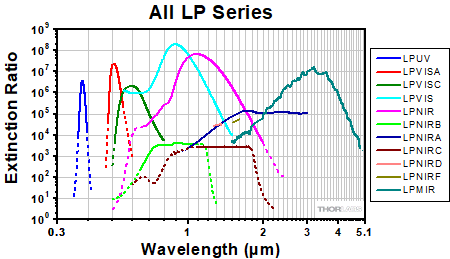
Click to Enlarge
The dashed line indicates where the linear polarizer is outside of the intended use wavelength range. For more details on a particular polarizer series see graphs below.
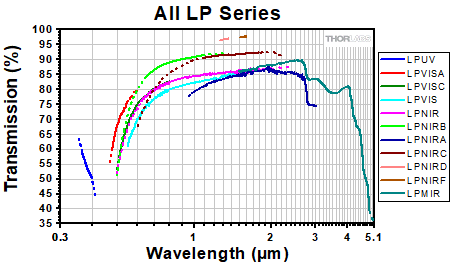
Click to Enlarge
The dashed line indicates where the linear polarizer is outside of the intended use wavelength range. For more details on a particular polarizer series see graphs below.
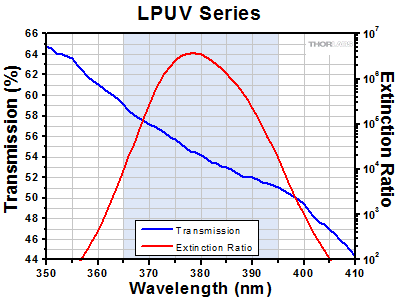
Click to Enlarge
Click to Download LPUV Series Transmission Data
This polarizer is intended for use in the 365 - 395 nm wavelength range.
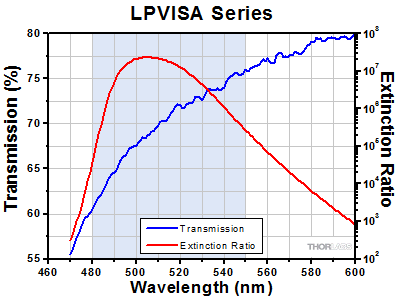
Click to Enlarge
Click to Download LPVISA Series Transmission Data
This polarizer is intended for use in the 480 - 550 nm wavelength range.
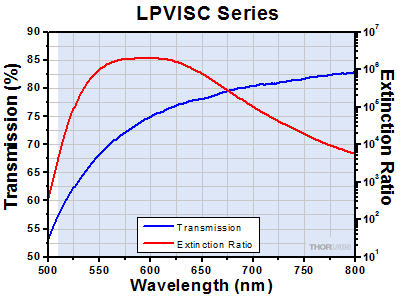
Click to Enlarge
Click to Download LPVISC Series Transmission Data
This polarizer is intended for use in the 510 - 800 nm wavelength range.
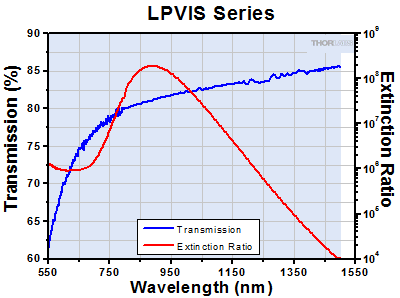
Click to Enlarge
Click to Download LPVIS Series Transmission Data
This polarizer is intended for use in the 550 nm - 1.5 µm wavelength range.
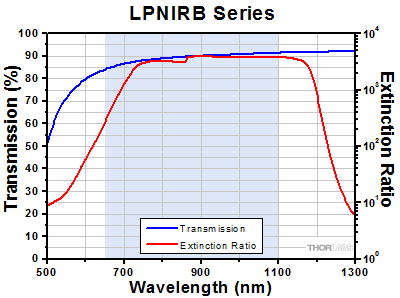
Click to Enlarge
Click to Download LPNIRB Transmission Data
This polarizer is intended for use in the 650 nm - 1.1 µm wavelength range.
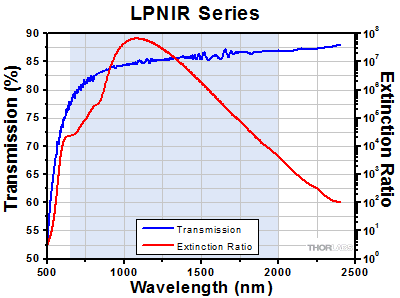
Click to Enlarge
Click to Download LPNIR Transmission Data
This polarizer is intended for use in the 650 nm - 2.0 µm wavelength range.
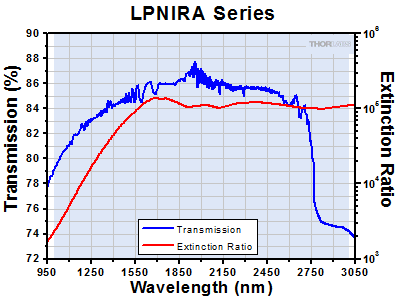
Click to Enlarge
Click to Download LPNIRA Transmission Data
This polarizer is intended for use in the 1.0 - 3.0 µm wavelength range.
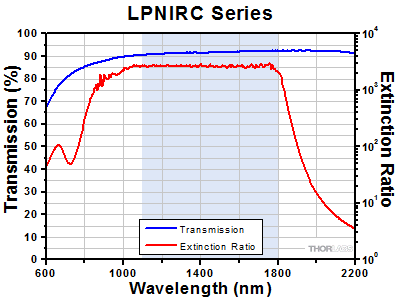
Click to Enlarge
Click to Download LPNIRC Transmission Data
This polarizer is intended for use in the 1.1 - 1.8 µm wavelength range.
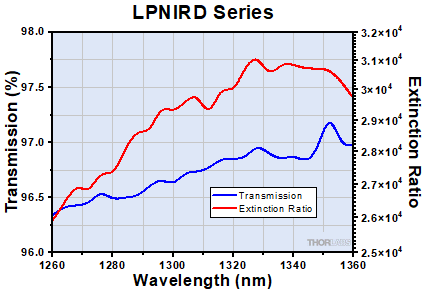
Click to Enlarge
Click to Download LPNIRD Transmission Data
This polarizer is intended for use in the 1.26 - 1.36 µm wavelength range.
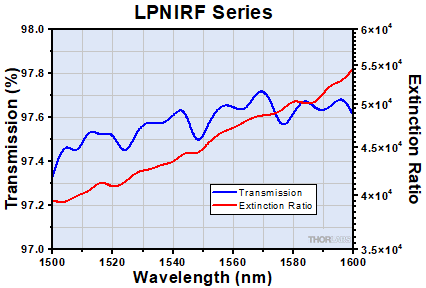
Click to Enlarge
Click to Download LPNIRF Transmission Data
This polarizer is intended for use in the 1.5 - 1.6 µm wavelength range.
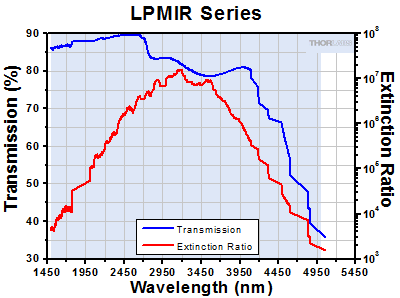
Click to Enlarge
Click to Download LPMIR Transmission Data
This polarizer is intended for use in the 1.5 - 5.0 µm wavelength range.
| Damage Threshold Specifications | ||
|---|---|---|
| Item # Prefix |
Damage Threshold | |
| CW | Pulsed | |
| LPUV | Unmounted Versions: 1 W/cm2 Continuous Block; 5 W/cm2 Continuous Pass Mounted Versions: 10 W/cm2 Continuous Block; 25 W/cm2 Continuous Pass |
- |
| LPVISA | ||
| LPVISC | ||
| LPVIS | ||
| LPNIR | ||
| LPNIRB | 10 W/cm2 Continuous Block; 25 W/cm2 Continuous Pass |
0.006 J/cm2 (800 nm, 100 Hz, 36.4 fs, Ø189 µm) 0.1 J/cm2 (810 nm, 7.2 ns, 10 Hz, Ø0.216 mm) |
| LPNIRA | 10 W/cm2 Continuous Block; 25 W/cm2 Continuous Pass |
- |
| LPNIRC | ||
| LPNIRD | ||
| LPNIRF | ||
| LPMIR | ||
Damage Threshold Data for Thorlabs' Nanoparticle Linear Film Polarizers
The specifications in the table to the right are for Thorlabs' Nanoparticle Linear Film Polarizers. Damage threshold specifications are constant for all nanoparticle linear film polarizers, regardless of the size of the polarizer.
Laser Induced Damage Threshold Tutorial
The following is a general overview of how laser induced damage thresholds are measured and how the values may be utilized in determining the appropriateness of an optic for a given application. When choosing optics, it is important to understand the Laser Induced Damage Threshold (LIDT) of the optics being used. The LIDT for an optic greatly depends on the type of laser you are using. Continuous wave (CW) lasers typically cause damage from thermal effects (absorption either in the coating or in the substrate). Pulsed lasers, on the other hand, often strip electrons from the lattice structure of an optic before causing thermal damage. Note that the guideline presented here assumes room temperature operation and optics in new condition (i.e., within scratch-dig spec, surface free of contamination, etc.). Because dust or other particles on the surface of an optic can cause damage at lower thresholds, we recommend keeping surfaces clean and free of debris. For more information on cleaning optics, please see our Optics Cleaning tutorial.
Testing Method
Thorlabs' LIDT testing is done in compliance with ISO/DIS 11254 and ISO 21254 specifications.
First, a low-power/energy beam is directed to the optic under test. The optic is exposed in 10 locations to this laser beam for 30 seconds (CW) or for a number of pulses (pulse repetition frequency specified). After exposure, the optic is examined by a microscope (~100X magnification) for any visible damage. The number of locations that are damaged at a particular power/energy level is recorded. Next, the power/energy is either increased or decreased and the optic is exposed at 10 new locations. This process is repeated until damage is observed. The damage threshold is then assigned to be the highest power/energy that the optic can withstand without causing damage. A histogram such as that below represents the testing of one BB1-E02 mirror.

The photograph above is a protected aluminum-coated mirror after LIDT testing. In this particular test, it handled 0.43 J/cm2 (1064 nm, 10 ns pulse, 10 Hz, Ø1.000 mm) before damage.

| Example Test Data | |||
|---|---|---|---|
| Fluence | # of Tested Locations | Locations with Damage | Locations Without Damage |
| 1.50 J/cm2 | 10 | 0 | 10 |
| 1.75 J/cm2 | 10 | 0 | 10 |
| 2.00 J/cm2 | 10 | 0 | 10 |
| 2.25 J/cm2 | 10 | 1 | 9 |
| 3.00 J/cm2 | 10 | 1 | 9 |
| 5.00 J/cm2 | 10 | 9 | 1 |
According to the test, the damage threshold of the mirror was 2.00 J/cm2 (532 nm, 10 ns pulse, 10 Hz, Ø0.803 mm). Please keep in mind that these tests are performed on clean optics, as dirt and contamination can significantly lower the damage threshold of a component. While the test results are only representative of one coating run, Thorlabs specifies damage threshold values that account for coating variances.
Continuous Wave and Long-Pulse Lasers
When an optic is damaged by a continuous wave (CW) laser, it is usually due to the melting of the surface as a result of absorbing the laser's energy or damage to the optical coating (antireflection) [1]. Pulsed lasers with pulse lengths longer than 1 µs can be treated as CW lasers for LIDT discussions.
When pulse lengths are between 1 ns and 1 µs, laser-induced damage can occur either because of absorption or a dielectric breakdown (therefore, a user must check both CW and pulsed LIDT). Absorption is either due to an intrinsic property of the optic or due to surface irregularities; thus LIDT values are only valid for optics meeting or exceeding the surface quality specifications given by a manufacturer. While many optics can handle high power CW lasers, cemented (e.g., achromatic doublets) or highly absorptive (e.g., ND filters) optics tend to have lower CW damage thresholds. These lower thresholds are due to absorption or scattering in the cement or metal coating.

LIDT in linear power density vs. pulse length and spot size. For long pulses to CW, linear power density becomes a constant with spot size. This graph was obtained from [1].

Pulsed lasers with high pulse repetition frequencies (PRF) may behave similarly to CW beams. Unfortunately, this is highly dependent on factors such as absorption and thermal diffusivity, so there is no reliable method for determining when a high PRF laser will damage an optic due to thermal effects. For beams with a high PRF both the average and peak powers must be compared to the equivalent CW power. Additionally, for highly transparent materials, there is little to no drop in the LIDT with increasing PRF.
In order to use the specified CW damage threshold of an optic, it is necessary to know the following:
- Wavelength of your laser
- Beam diameter of your beam (1/e2)
- Approximate intensity profile of your beam (e.g., Gaussian)
- Linear power density of your beam (total power divided by 1/e2 beam diameter)
Thorlabs expresses LIDT for CW lasers as a linear power density measured in W/cm. In this regime, the LIDT given as a linear power density can be applied to any beam diameter; one does not need to compute an adjusted LIDT to adjust for changes in spot size, as demonstrated by the graph to the right. Average linear power density can be calculated using the equation below.

The calculation above assumes a uniform beam intensity profile. You must now consider hotspots in the beam or other non-uniform intensity profiles and roughly calculate a maximum power density. For reference, a Gaussian beam typically has a maximum power density that is twice that of the uniform beam (see lower right).
Now compare the maximum power density to that which is specified as the LIDT for the optic. If the optic was tested at a wavelength other than your operating wavelength, the damage threshold must be scaled appropriately. A good rule of thumb is that the damage threshold has a linear relationship with wavelength such that as you move to shorter wavelengths, the damage threshold decreases (i.e., a LIDT of 10 W/cm at 1310 nm scales to 5 W/cm at 655 nm):

While this rule of thumb provides a general trend, it is not a quantitative analysis of LIDT vs wavelength. In CW applications, for instance, damage scales more strongly with absorption in the coating and substrate, which does not necessarily scale well with wavelength. While the above procedure provides a good rule of thumb for LIDT values, please contact Tech Support if your wavelength is different from the specified LIDT wavelength. If your power density is less than the adjusted LIDT of the optic, then the optic should work for your application.
Please note that we have a buffer built in between the specified damage thresholds online and the tests which we have done, which accommodates variation between batches. Upon request, we can provide individual test information and a testing certificate. The damage analysis will be carried out on a similar optic (customer's optic will not be damaged). Testing may result in additional costs or lead times. Contact Tech Support for more information.
Pulsed Lasers
As previously stated, pulsed lasers typically induce a different type of damage to the optic than CW lasers. Pulsed lasers often do not heat the optic enough to damage it; instead, pulsed lasers produce strong electric fields capable of inducing dielectric breakdown in the material. Unfortunately, it can be very difficult to compare the LIDT specification of an optic to your laser. There are multiple regimes in which a pulsed laser can damage an optic and this is based on the laser's pulse length. The highlighted columns in the table below outline the relevant pulse lengths for our specified LIDT values.
Pulses shorter than 10-9 s cannot be compared to our specified LIDT values with much reliability. In this ultra-short-pulse regime various mechanics, such as multiphoton-avalanche ionization, take over as the predominate damage mechanism [2]. In contrast, pulses between 10-7 s and 10-4 s may cause damage to an optic either because of dielectric breakdown or thermal effects. This means that both CW and pulsed damage thresholds must be compared to the laser beam to determine whether the optic is suitable for your application.
| Pulse Duration | t < 10-9 s | 10-9 < t < 10-7 s | 10-7 < t < 10-4 s | t > 10-4 s |
|---|---|---|---|---|
| Damage Mechanism | Avalanche Ionization | Dielectric Breakdown | Dielectric Breakdown or Thermal | Thermal |
| Relevant Damage Specification | No Comparison (See Above) | Pulsed | Pulsed and CW | CW |
When comparing an LIDT specified for a pulsed laser to your laser, it is essential to know the following:

LIDT in energy density vs. pulse length and spot size. For short pulses, energy density becomes a constant with spot size. This graph was obtained from [1].
- Wavelength of your laser
- Energy density of your beam (total energy divided by 1/e2 area)
- Pulse length of your laser
- Pulse repetition frequency (prf) of your laser
- Beam diameter of your laser (1/e2 )
- Approximate intensity profile of your beam (e.g., Gaussian)
The energy density of your beam should be calculated in terms of J/cm2. The graph to the right shows why expressing the LIDT as an energy density provides the best metric for short pulse sources. In this regime, the LIDT given as an energy density can be applied to any beam diameter; one does not need to compute an adjusted LIDT to adjust for changes in spot size. This calculation assumes a uniform beam intensity profile. You must now adjust this energy density to account for hotspots or other nonuniform intensity profiles and roughly calculate a maximum energy density. For reference a Gaussian beam typically has a maximum energy density that is twice that of the 1/e2 beam.
Now compare the maximum energy density to that which is specified as the LIDT for the optic. If the optic was tested at a wavelength other than your operating wavelength, the damage threshold must be scaled appropriately [3]. A good rule of thumb is that the damage threshold has an inverse square root relationship with wavelength such that as you move to shorter wavelengths, the damage threshold decreases (i.e., a LIDT of 1 J/cm2 at 1064 nm scales to 0.7 J/cm2 at 532 nm):

You now have a wavelength-adjusted energy density, which you will use in the following step.
Beam diameter is also important to know when comparing damage thresholds. While the LIDT, when expressed in units of J/cm², scales independently of spot size; large beam sizes are more likely to illuminate a larger number of defects which can lead to greater variances in the LIDT [4]. For data presented here, a <1 mm beam size was used to measure the LIDT. For beams sizes greater than 5 mm, the LIDT (J/cm2) will not scale independently of beam diameter due to the larger size beam exposing more defects.
The pulse length must now be compensated for. The longer the pulse duration, the more energy the optic can handle. For pulse widths between 1 - 100 ns, an approximation is as follows:

Use this formula to calculate the Adjusted LIDT for an optic based on your pulse length. If your maximum energy density is less than this adjusted LIDT maximum energy density, then the optic should be suitable for your application. Keep in mind that this calculation is only used for pulses between 10-9 s and 10-7 s. For pulses between 10-7 s and 10-4 s, the CW LIDT must also be checked before deeming the optic appropriate for your application.
Please note that we have a buffer built in between the specified damage thresholds online and the tests which we have done, which accommodates variation between batches. Upon request, we can provide individual test information and a testing certificate. Contact Tech Support for more information.
[1] R. M. Wood, Optics and Laser Tech. 29, 517 (1998).
[2] Roger M. Wood, Laser-Induced Damage of Optical Materials (Institute of Physics Publishing, Philadelphia, PA, 2003).
[3] C. W. Carr et al., Phys. Rev. Lett. 91, 127402 (2003).
[4] N. Bloembergen, Appl. Opt. 12, 661 (1973).
In order to illustrate the process of determining whether a given laser system will damage an optic, a number of example calculations of laser induced damage threshold are given below. For assistance with performing similar calculations, we provide a spreadsheet calculator that can be downloaded by clicking the button to the right. To use the calculator, enter the specified LIDT value of the optic under consideration and the relevant parameters of your laser system in the green boxes. The spreadsheet will then calculate a linear power density for CW and pulsed systems, as well as an energy density value for pulsed systems. These values are used to calculate adjusted, scaled LIDT values for the optics based on accepted scaling laws. This calculator assumes a Gaussian beam profile, so a correction factor must be introduced for other beam shapes (uniform, etc.). The LIDT scaling laws are determined from empirical relationships; their accuracy is not guaranteed. Remember that absorption by optics or coatings can significantly reduce LIDT in some spectral regions. These LIDT values are not valid for ultrashort pulses less than one nanosecond in duration.

A Gaussian beam profile has about twice the maximum intensity of a uniform beam profile.
CW Laser Example
Suppose that a CW laser system at 1319 nm produces a 0.5 W Gaussian beam that has a 1/e2 diameter of 10 mm. A naive calculation of the average linear power density of this beam would yield a value of 0.5 W/cm, given by the total power divided by the beam diameter:

However, the maximum power density of a Gaussian beam is about twice the maximum power density of a uniform beam, as shown in the graph to the right. Therefore, a more accurate determination of the maximum linear power density of the system is 1 W/cm.
An AC127-030-C achromatic doublet lens has a specified CW LIDT of 350 W/cm, as tested at 1550 nm. CW damage threshold values typically scale directly with the wavelength of the laser source, so this yields an adjusted LIDT value:

The adjusted LIDT value of 350 W/cm x (1319 nm / 1550 nm) = 298 W/cm is significantly higher than the calculated maximum linear power density of the laser system, so it would be safe to use this doublet lens for this application.
Pulsed Nanosecond Laser Example: Scaling for Different Pulse Durations
Suppose that a pulsed Nd:YAG laser system is frequency tripled to produce a 10 Hz output, consisting of 2 ns output pulses at 355 nm, each with 1 J of energy, in a Gaussian beam with a 1.9 cm beam diameter (1/e2). The average energy density of each pulse is found by dividing the pulse energy by the beam area:

As described above, the maximum energy density of a Gaussian beam is about twice the average energy density. So, the maximum energy density of this beam is ~0.7 J/cm2.
The energy density of the beam can be compared to the LIDT values of 1 J/cm2 and 3.5 J/cm2 for a BB1-E01 broadband dielectric mirror and an NB1-K08 Nd:YAG laser line mirror, respectively. Both of these LIDT values, while measured at 355 nm, were determined with a 10 ns pulsed laser at 10 Hz. Therefore, an adjustment must be applied for the shorter pulse duration of the system under consideration. As described on the previous tab, LIDT values in the nanosecond pulse regime scale with the square root of the laser pulse duration:

This adjustment factor results in LIDT values of 0.45 J/cm2 for the BB1-E01 broadband mirror and 1.6 J/cm2 for the Nd:YAG laser line mirror, which are to be compared with the 0.7 J/cm2 maximum energy density of the beam. While the broadband mirror would likely be damaged by the laser, the more specialized laser line mirror is appropriate for use with this system.
Pulsed Nanosecond Laser Example: Scaling for Different Wavelengths
Suppose that a pulsed laser system emits 10 ns pulses at 2.5 Hz, each with 100 mJ of energy at 1064 nm in a 16 mm diameter beam (1/e2) that must be attenuated with a neutral density filter. For a Gaussian output, these specifications result in a maximum energy density of 0.1 J/cm2. The damage threshold of an NDUV10A Ø25 mm, OD 1.0, reflective neutral density filter is 0.05 J/cm2 for 10 ns pulses at 355 nm, while the damage threshold of the similar NE10A absorptive filter is 10 J/cm2 for 10 ns pulses at 532 nm. As described on the previous tab, the LIDT value of an optic scales with the square root of the wavelength in the nanosecond pulse regime:

This scaling gives adjusted LIDT values of 0.08 J/cm2 for the reflective filter and 14 J/cm2 for the absorptive filter. In this case, the absorptive filter is the best choice in order to avoid optical damage.
Pulsed Microsecond Laser Example
Consider a laser system that produces 1 µs pulses, each containing 150 µJ of energy at a repetition rate of 50 kHz, resulting in a relatively high duty cycle of 5%. This system falls somewhere between the regimes of CW and pulsed laser induced damage, and could potentially damage an optic by mechanisms associated with either regime. As a result, both CW and pulsed LIDT values must be compared to the properties of the laser system to ensure safe operation.
If this relatively long-pulse laser emits a Gaussian 12.7 mm diameter beam (1/e2) at 980 nm, then the resulting output has a linear power density of 5.9 W/cm and an energy density of 1.2 x 10-4 J/cm2 per pulse. This can be compared to the LIDT values for a WPQ10E-980 polymer zero-order quarter-wave plate, which are 5 W/cm for CW radiation at 810 nm and 5 J/cm2 for a 10 ns pulse at 810 nm. As before, the CW LIDT of the optic scales linearly with the laser wavelength, resulting in an adjusted CW value of 6 W/cm at 980 nm. On the other hand, the pulsed LIDT scales with the square root of the laser wavelength and the square root of the pulse duration, resulting in an adjusted value of 55 J/cm2 for a 1 µs pulse at 980 nm. The pulsed LIDT of the optic is significantly greater than the energy density of the laser pulse, so individual pulses will not damage the wave plate. However, the large average linear power density of the laser system may cause thermal damage to the optic, much like a high-power CW beam.
| Posted Comments: | |
user
(posted 2024-05-22 16:36:54.47) Hello,
I would like to inquire about the LPVIS product. When used for long periods (below the damage threshold), does the transmission change due to the thermal effects from light absorption by the polarizer? Or does the transmission remain constant over time?
Thank you. dpossin
(posted 2024-05-24 04:53:26.0) Dear customer,
Since the transmission, the LPVIS provides is rather high, there is no thermal effect on the transmission expected as long as the damage threshold are maintained. Kilian Muller
(posted 2024-02-29 11:01:27.1) Bonjour,
I was looking for the transmission data for your LPNIRB100 polarizer - like you provide for your economy film polarizers - but could not find it.
Specifically, I am interested in the transmission and extinction ratio at 780 nm.
I would be very happy if you could send me that data.
Furthermore I would like to know whether it was possible for you to sell this polarizer in a rectangular shape (let's say 20 mm x 30 mm), with the polarization axis aligned with one of the axes of the rectangle.
Best regards,
Kilian Muller cdolbashian
(posted 2024-03-18 04:34:58.0) Thank you for contacting Thorlabs. The raw data for transmission and ER can be downloaded by clicking the hyperlink under the "Graphs" tab. (Please note that the data shown here is typical; slight variations in performance data may occur from lot to lot.) The typical transmission and ER of the LPNIRB series for 780nm are 88.6432% and 3180.70979, respectively. We can provide a custom rectangular shape upon request. We will contact you directly to discuss the possibility of offering this customization. Alternatively, feel free to reach out to your local Tech Support group ( techsupport.fr@thorlabs.com in your case) in the future when inquiring about custom versions of stock items in our web catalog user
(posted 2024-01-15 21:32:57.527) Is there an inherent physical reason, why the Operating
Temperature range is limited down to -20°C (like shifts in the nanoparticles absorption)? Or could the polarizer in principle also be used at cryogenic temperatures (-210°C)(damage caused by breakage due to stresses in the glass etc. neglected)? hkarpenko
(posted 2024-01-18 04:02:52.0) Dear Stefan,
thank you very much for your feedback. The specified temperature range is limited due to the properties of the material and this is the safe range to use it. However I will contact you directly to discuss further possibilities with you. APR TriLite
(posted 2023-12-18 13:33:44.91) Hi, I see a beam displacement in case of mounted as well as unmounted polarizers. This manifests as the beam rotating about the axis of the polarizer when the polarizer is rotated. I have noticed it in LPVIS050-MP2 and in LPVISE100-A. I have tried to mount the polarizer as normal to the beam as possible,but this still exists. Could you please explain why this happens ? Also, is this angular beam displacement given by the property parallelism in the Specs tab. For all mounted polarizers this is indicated to be 20 arc minutes. Am I understanding it correct that this will amount to a beam displacement of 0.58mm per 100 mm of beam propagation ? hchow
(posted 2023-12-19 05:39:42.0) Dear Sir/Madam, thank you for your enquiry. The beam displacement you are observing is indeed due to the unfortunate consequence of the 20 arcmin parallelism of the polariser. 0,58 mm shift per 100 mm beam propagation is also correct. If you wish to minimise the beam displacement, I can suggest that you purchase our unmounted polarisers instead, as the parallelism is specced at just 1 arcmin only. Garland Best
(posted 2023-07-26 07:40:41.113) We are wittnessing an issue with the polarizers we ordered. There is a background pattern of light being scattered around the central beam we are blocking. This scattered light is being detected by our measurements, limiting our ability to measure the polarization state of the light. being transmitted. I can provide images to show this.
Please contact us ASAP so we can resolve this. Thank you. hkarpenko
(posted 2023-07-28 04:24:32.0) Dear Garland,
thank you for your feedback. This issue can have several reasons. For instance the AOI or wavelength of you beam. I will contact you directly to discuss this in detail with you. user
(posted 2023-06-02 14:51:31.727) Hello, what are the optical consequences of having a polarizer before or after the imaging lens?
Thank you hchow
(posted 2023-06-05 11:02:05.0) Thank you for contacting us!
Differences in putting a polarizer before or after the lens can be manifold. For instance, in general, putting a flat substrate after the lens will create aberrations that may increase the spot size and focal length of the lens more than putting it before the lens.
On the other hand, putting a polarizer after the lens may help reduce glare effect originating in the lens itself in case it consists of multiple optical elements. Presence of a glare effect may be also related on the quality of the lens.
We will contact you directly to discuss further details of your setup. hchow
(posted 2023-06-05 11:02:05.0) Thank you for contacting us!
Differences in putting a polarizer before or after the lens can be manifold. For instance, in general, putting a flat substrate after the lens will create aberrations that may increase the spot size and focal length of the lens more than putting it before the lens.
On the other hand, putting a polarizer after the lens may help reduce glare effect originating in the lens itself in case it consists of multiple optical elements. Presence of a glare effect may be also related on the quality of the lens.
We will contact you directly to discuss further details of your setup. Yutong Feng
(posted 2023-03-30 09:37:34.87) Hello,
To use the LPNIR100-MP2 properly, should the incident
collimated beam be in the center of the polarizer? What would be changed, eg transmission, if the beam not hitting the center but close to the edge?
Many thanks. hchow
(posted 2023-04-03 07:56:33.0) Dear Ms. Feng, thank you for your feedback. So long as the collimated laser beam is incident on the surface and well within the diameter of the polariser, there should not be any degradation in the transmission ratio of the output beam. John McPhillimy
(posted 2022-11-03 04:01:51.457) Hello,
I was hoping for some information on the polarization filter extinction relative to angular incidence of input source beam.
If the input beam is deflected prior to the polariser such that we have a 5-40degree angle away from the normal, how does this impact the polarisation control via the polarizer?
This is if we are working in both a linear and circular state prior to the final polariser.
Thank you, John hkarpenko
(posted 2022-11-08 08:04:07.0) Dear John,
thank you for your feedback.
The incident angle has an impact on the ER. However, for these polarisers we specify an acceptance angle of ±20°. That means, in that region the ER won´t change much and will be in the range of the specifications we state, but best performance is achieved using 0° AOI.
I contact you directly to discuss this topic further with you. user
(posted 2022-07-15 13:15:43.007) ... and I would like to ask the same thing, regarding the preferred direction of propagation of light, for LPVISA100-MP2, 480 - 550 nm. Thank you mdiekmann
(posted 2022-07-18 11:32:57.0) Thank you for contacting us! These can be used in both directions. We will contact you directly to troubleshoot this issue. user
(posted 2022-07-15 12:31:16.83) Hi, I would like to ask which is the preferred direction of propagation of light, for LPNIR100-MP2 - Ø25.0 mm SM1, 650-2000 nm. I ask because there is no arrow on the ring, and I see a difference depending on the orientation. Thanks you very much Antoni Kocot
(posted 2022-04-05 11:22:10.803) Quote
LPVISB100 - Ø25.0 mm Unmounted Linear Polarizer, 500 - 720 nm jgreschler
(posted 2022-04-06 03:17:52.0) Thank you for reaching out to Thorlabs. LPVISB100 was obsoleted in June 2017, the replacement product is LPVISC100. The two units have the same size, the focal range is slightly shifted for the new unit (510-800nm versus 500-720 for the old unit). I have reached out to you directly to confirm replacement and set up a quote. user
(posted 2021-06-08 15:48:50.887) Hi, I am wondering why you didn't specify the extinction ratio of > 100 000:1 for LPVISA in the table of extinction ratio bands? I would like to know which one (LPVISA and LPVISC) is better for 532-nm laser. Thanks. MKiess
(posted 2021-06-11 09:14:59.0) This is a response from Michael at Thorlabs. Thank you very much for your inquiry. The LPVISA has the better extinction ratio at 532nm. You can see the comparison very well in the Extinction Ratio Graph, which you can find in the Linear Polarizer Selection Guide table, in the Overview Tab.
I have contacted you directly for further support. Vladimir Makarov
(posted 2020-06-04 10:20:40.07) Hello,
The Solidworks 3D CAD model for this part is in German. Could you please fix this and make it in English. We are using this model in our equipment assembly 3D CAD, and the German is confusing. MKiess
(posted 2020-06-10 06:20:03.0) This is a response from Michael at Thorlabs. Thank you very much for your feedback. That's correct. We will adjust that immediately. Thank you very much for this information. Angel Fernandez
(posted 2020-01-31 04:05:34.34) Hi,
What is the refraction index of the LPVISC100-MP2 polarizer at 633nm wavelength? Thank you in advance. MKiess
(posted 2020-02-03 11:27:53.0) This is a response from Michael at Thorlabs. Thank you very much for your inquiry. The refraction index of the LPVISC100-MP2 polarizer at 633nm is ~1.52. I have sent you contacted you directly to provide further details. Seungeun Oh
(posted 2019-08-21 02:59:19.98) Has anyone tried if these polarizers work for 2W, 700 - 1064 nm NIR pulse lasers of ~200 fsec pulse duration, 80 MHz repetition rate? The average irradiance is 0.4 W/mm2, and estimated peak irradiance is 40 kW/mm2. MKiess
(posted 2019-08-22 11:47:41.0) This is a response from Michael at Thorlabs. Thank you very much for your inquiry. We once tested an LPNIRA100-MP2 with a 150fs pulsed laser at a wavelength of 2200nm with an average power density of 0.16W/mm^2. The repetition rate was 82Hz. The filter did not withstand this laser. Therefore the filter will not withstand a laser with the specifications described by you. Petter Westbergh
(posted 2019-05-16 11:00:45.26) How does the polarizer's transmission axis align with the marks on the side of the polarizer? YLohia
(posted 2019-05-16 02:52:43.0) The polarizer's transmission axis is indicated by two black marks on the edge of every unmounted polarizer except the LPNIRA050, LPMIR050, LPNIRA100, and LPMIR100. On the mounted polarizers, the polarization axis is indicated by engraved white lines on the housing. adarshjain
(posted 2018-08-29 03:22:18.73) Hi,
We want to procure LPNIR100-MP2 polarizer.
Our pulsed laser o/p requirements is as follows;
(a) Pavg: 100mW
(b) repetition rate: 10 MHz
(c) Pulse duration: 10ns
As laser damage threshold is written as 25W/cm2, can we use it for our application?
Please reply on urgent basis. nreusch
(posted 2018-09-06 04:53:34.0) This is a response from Nicola at Thorlabs. Thank you for your inquiry. In order to determine the intensity of your laser beam, I need to know the beam diameter. Would you like to use it in pass orientation only? I will contact you directly to discuss this in more detail. ivan.sytcevich
(posted 2018-05-07 10:48:34.937) Hello,
I was wondering if you make custom sized thin film polarizers. I need two rectangular polarizers with dimensions of 8 x3.5 mm (visible - NIR range) in order to use them with the SLM for amplitude modulation. swick
(posted 2018-05-15 03:49:11.0) This is a response from Sebastian at Thorlabs. Thank you for the inquiry.
We can offer the Nanoparticle Film Polarizer with customized dimensions. I contacted you directly. ahackler
(posted 2017-06-28 10:32:28.59) I am slightly confused by how you explain the CW damage threshold as some of the terms aren't defined. My question is: I have a 488nm CW laser operating at 20mW with a beam diameter of 0.7 mm, would the film polarizers survive? wskopalik
(posted 2017-06-29 04:28:54.0) This is a response from Wolfgang at Thorlabs. Thank you very much for your inquiry.
There are two damage threshold values specified for these polarizers. This is because the damage threshold depends on how the polarisation of the incoming light is oriented with regards to the polarizer. If the light is oriented so it is blocked by the polarizer, the light will be absorbed in the polarizer. This generates heat and can damage the polarizer if the power of the light is too high. In pass direction much less absorption takes place, therefore the applied power can be higher.
In your case the power density is about 5.2 W/cm2. This is too much for the LPVISA050 even in pass direction. So the polarizer would be damaged. An alternative would be the mounted version LPVISA050-MP2 which has the same extinction ratio but can handle higher powers. This is because the mounted version doesn't have lamination layers.
I will contact you directly to provide further assistance. kko
(posted 2017-06-07 09:48:56.33) Hello,
I want to use the LPVIS100.
Is there any evaluation about the homogeneity of the ER over the surface ?
The guarantied ER at specific wavelength is several orders below the theoretical calculated. Is there a knowledge about the variance to be expected ?
greetings
martin swick
(posted 2017-06-14 03:26:10.0) This is a response from Sebastian at Thorlabs. Thank you for the inquiry.
The fluctuation of the ER at the Nanoparticle Linear Film Polarizer over the clear aperture is very small. I have contacted you directly to provide assistance. zhiheng
(posted 2015-10-27 23:43:34.93) Hi there, I have a couple of LPVISB050-MP2 polarizers in my lab. Over the course of a couple of months, the polarizers develop a discoloration that is accompanied by a dramatic decrease in the extinction ratio (<10:1), making them unusable. This is even though the polarizers are used mostly with their polarization axes aligned with that of the incident laser beam. The incident laser beam has the following parameters: ~6 mW average power, 1 kHz pulse repetition rate, <10 fs pulse duration, 5 mm beam diameter (1/e^2), 550 - 720 nm wavelength. What could be causing the polarizers to be damaged? I would like to use these polarizers as much as possible because their thin substrates make them compatible with ultrashort pulses. Any advice that you can provide would be greatly appreciated. Thank you! besembeson
(posted 2015-10-28 05:39:46.0) Response from Bweh at Thorlabs USA: Though your average power is low, with such ultra-short pulses, the dominant damage mechanism is avalanche ionization. It is not clear however if the discoloration is random on the surface or only around areas used with the beam. I will contact you to clarify this further. elijah.dale
(posted 2015-03-06 13:19:03.85) What is the index of refraction of the polarizer (LPNIR050) at a wavelength of 1.55 um? shallwig
(posted 2015-03-09 10:29:48.0) This is a response from Stefan at Thorlabs. Thank you very much for your inquiry. The LPNIR050 has the same optical properties as B270 glass but unfortunately we do not have specific data for the refractive index at 1550nm. I will contact you directly to discuss your application in more detail. ysu
(posted 2014-08-22 17:03:27.62) Does the incident angle affect the extinction ratio?
Can a diverging beam be polarized by this thin film polarizer? shallwig
(posted 2014-08-25 06:05:59.0) This is a response from Stefan at Thorlabs. Thank you very much for your inquiry. The incident angle affects the extinction ratio but within specified +/-20° acceptance angle the specifications of the extinction ratio are valid. In general it is possible to polarize a divergent beam but the single beams which come from different incident angles may have different extinction ratios.I will contact you directly to discuss your application in detail. user
(posted 2014-06-08 15:27:13.417) Is it possible to have LPNIR100 with AR coating?
The AR coating should be optimized for NIR (900-1700nm), but should have effect at 500-900nm to. jlow
(posted 2014-06-12 01:54:00.0) Response from Jeremy at Thorlabs: We are able to offer LPNIR100 with an AR coating. However, a broadband coating from 500-1700 will be difficult to achieve with low reflectivity. Since you did not leave any contact information, can you contact your local Tech Support office to discuss about your requirements for the AR coating please? branderson
(posted 2013-12-13 11:47:54.463) I am slightly confused by how you explain the CW damage threshold as some of the terms aren't defined. My question is: I have a 532nm CW laser operating at 10W with a beam diameter of 2.25 mm, would the film polarizers survive? or do I need to go with a Glan-Taylor? jlow
(posted 2013-12-19 04:18:35.0) Response from Jeremy at Thorlabs: The continuous block means that the polarization of a CW source is perpendicular to the polarization axis of the polarizer. Continuous pass means that the polarization of a CW source is in-line with the polarization axis of the polarizer. These nanoparticle polarizers would not be suitable for your 10W beam. I would recommend the glan-laser calcite polarizer instead which can be found at http://www.thorlabs.com/newgrouppage9.cfm?objectgroup_id=815. inter99
(posted 2013-10-21 09:30:18.65) Is it possible to buy LPVIS(50 or 100) with no substrate material? Previously, I purchased a polarizer without substrate.
Thank you. tschalk
(posted 2013-10-21 09:16:00.0) This is a response from Thomas at Thorlabs. Thank you very much for your inquiry. We can offer the LPVIS without substrate material. I will contact you directly with more detailed information. christian.b.schmidt
(posted 2013-07-10 07:25:24.22) Do you have any information about the beam displacement? (Polarizator turning from 0-45-90-180 deg?) jvigroux
(posted 2013-07-23 10:56:00.0) a response form Julien at Thorlabs: thank you for your inquiry! the maximum beam displacement we specify is 20 arc min. jvigroux
(posted 2012-12-24 03:11:00.0) A response from Julien at Thorlabs: Thank you for your interest in our products! The transmission of the polarizers is wavelength dependent and can be seen under the tab "Graphs" of their product page. Concerning the waveplates, we specify a reflectance of less than 0.5% per surface (0.25% for the multi-order waveplates) and the absorption is that of fused silica so that a transmission >97% should normally be achieved. 77071191
(posted 2012-12-24 01:44:58.023) I want to know the transimission of the plorizer LPVIS050 and 1/4 waveplate,could you help me ? bdada
(posted 2012-06-05 19:34:00.0) Response from Buki at Thorlabs to ariyad2:
Thank you for your feedback. We are reviewing your request and will contact you with more information shortly. hariyad2
(posted 2012-05-31 05:45:26.0) Do you have Calibrated Linear Polarizer (at 0 and 45 deg oriented) to sell ? If yes, how does the price ?
Thanks
Hary, Finland bdada
(posted 2012-02-08 20:26:00.0) Response from Buki at Thorlabs:
The acceptance angle of the polarizer is +/- 20 degrees, due to losses from Fresnel reflections. This information is included in the "Specs" tab on the web page.
Please contact TechSupport@thorlabs.com if you have any questions. user
(posted 2012-01-31 01:43:46.0) Is the polarizer dependent on AOI? bdada
(posted 2011-07-26 20:48:00.0) Response from Buki at Thorlabs:
We don’t have the test data for your specific laser pulse width. The damage threshold for the LPNIR050 is 3 mJ/cm^2 at 1064 nm with 6 ns pulse width. Please contact TechSupport@thorlabs.com if you have additional questions or to discuss the specifications of your laser so we can determine if the LPNIR polarizer is suitable for your application. Mikhail.Levin
(posted 2011-07-26 14:49:02.0) Please inform about the Laser damage Threshold for LPNIR polarizer in the case of 1064 short pulse laser (pulse ~1 psec) jvigroux
(posted 2011-06-03 10:21:00.0) A response from Julien at Thorlabs: The difference between the specification and the graph arises from the fact that the specified ER concerns the whole wavelength range and is thus a lower limit. The graph data on the other hand corresponds to a typical data and is therefore not to be considered as an absolute specification. I will contact you directly in order to see which solution would be the most adapted for your application. federica.beduini
(posted 2011-06-02 12:20:58.0) In the graph section one can see that the LPVIS series can reach an extinction ratio of 10^8 for 800 nm, but in the specs you guarantee only >10^5 extinction ratio.
Is it possible to order custom product which satisfies the 10^8 specification? I will work with a wavelength of 795 nm. Thanks! tor
(posted 2010-12-09 10:04:18.0) Response from Tor at Thorlabs to Dimitri: Thank you for your interest in our Nanoparticle Linear Film Polarizers. While these are not AR-coated, we may be able to offer AR-coated versions as a custom. I will contact you shortly to discuss your exact needs. Dimitri.Mawet
(posted 2010-12-08 16:45:07.0) Are there AR coatings on any of these polarizers, and if not, could you apply one ? If there is one, Id be interested in seeing the reflectance curves. Thanks. julien
(posted 2010-11-30 16:26:36.0) A response from Julien At Thorlabs: Dear Mike, we can offer custom sizes for the polarizers, both for small and large quantities. the LDT cannot be increased as the LPMIR is not laminated, in contrary to the other polarizers (hence the already higher damage threshold). However this value is valid only for CW lasers and will strongly vary when a pulsed laser source is used. I will contact you directly to further discuss your application and the possible use of our polarizers. mburda
(posted 2010-11-30 21:44:02.0) Hello, I have some questions about your LPMIR Polarizers.
Are you able to make these at custom sizes? We would only be ordering a few at a time for design phase, but potentially hundreds-thousands when in production.
For the MIR version, with a LDT of 10W/cm^2 block, is there a high power option? I ask because I saw in your discussion that there is a version with no adhesive.
This would be very helpful to get a response to these questions very soon. We are in the process of designing and doing a lot of quoting which this would be very important for us.
Could you give me a rough quote on quantities 5, 20, 50,100, 500 of the LPMIR, but with a 5mm diameter?
For now I am going to place an order for a few pieces for design testing.
Thank you for your time, I hope to hear from you as soon as possible.
Mike tor
(posted 2010-11-10 11:28:05.0) Response from Tor at Thorlabs to luis.dussan: Thank you for your interest in our products. We are working on testing damage thresholds for many of our optics. We currently have a fluence damage threshold of 3 mJ/cm^2, 6 ns, 1064 nm given for the LPNIR050. I will contact you to obtain more information on your application to determine whether these polarizers are suitable for you. luis.dussan
(posted 2010-11-08 21:29:50.0) re Nanoparticle Linear Film Polarizers
what is the Fluence DT for 1550nm 10ns 20Hz 100-400um diameter beam.
Thanks Thorlabs
(posted 2010-10-20 12:00:23.0) Response from Javier at Thorlabs to Baohua.Niu: the refractive index is determined not only by the glass substrate, but by the particles used, as well. The values are as follows:
At 1064 nm: 1.5120
At 1340 nm: 1.5900 Baohua.Niu
(posted 2010-10-20 01:12:21.0) Can some one from the technical support department tell me whats the refraction index of the LPNIR100 polarizer at 1064nm and 1340nm wavelength? Is it just the refraction index of the glass substrate or something else?
Thanks,
Baohua.Niu@intel.com julien
(posted 2010-10-05 12:54:20.0) a Response from Julien at Thorlabs: The thin film polarizer is sandwiched between two glass plates that are glued together. The glue itself is not UHV compatible. We can also offer unlaminated polarizers that do not use any glue. As a result, there should be no outgasing problem for UHV applications. I will contact you directly to further discuss your application and see which type of polarizer would be best for your application. badgie
(posted 2010-10-04 16:23:40.0) Can you comment on the UHV compatibility of the unmounted polarizers? Thanks Thorlabs
(posted 2010-08-25 11:16:42.0) Response from Javier at Thorlabs to lawrence.berg: Thank you for your feedback. The correct specifications for damage threshold of these linear polarizers are those on the web (1 W/cm^2 block, 5 W/cm^2 pass). This is on our catalog corrections list and we will update the catalog pdf on the web. lawrence.berg
(posted 2010-08-25 09:18:52.0) Damage threshold on the LPNIR series. Web page states 1w/cm2 block, 5w/cm2 pass. The catalog page states 10W/cm2 block, 25W/cm2 pass. Which is it? The difference is crucial to to me. Thanks. Thorlabs
(posted 2010-07-21 08:38:02.0) Response from Javier at Thorlabs to lunxus.inc: Thank you for your feedback. The current lead time for the LPVIS050-MP is one week. lynxus.inc
(posted 2010-07-20 15:43:17.0) Please inform asap the Lead Time for this product.
Thanks
Abrao zatz
LynxUS Inc. klee
(posted 2009-11-12 11:08:24.0) A response from Ken at Thorlabs to physics_nt: These conditions can be critical. We would thus recommend going with a special non-laminated version because it does not contain glue. If you would like to get a quotation for this, please send your full contact information to techsupport@thorlabs.com and also confirm the size that you need. physics_nt
(posted 2009-11-10 13:44:15.0) In response to Ken: 800nm peak, 10 nm bandwidth, ~6-8 mm diameter, 500 uJ pulse energy, 200 fs, 1 kHz. Typically, the polarizer would see about 100 uJ. klee
(posted 2009-11-10 10:27:59.0) A response from Ken at Thorlabs to physics_nt:
A good guideline is 1MW/cm² pulse peak power.
We will be happy to check if the polarizer is suitable for your laser if you can provide wavelength, beam diameter, peak power, pulse length, and repetition rate. physics_nt
(posted 2009-11-06 16:15:24.0) Is there any information available about pulsed laser damage threshold? klee
(posted 2009-09-04 11:36:04.0) A response from Ken at Thorlabs to bdeng: The transmittance should not have any unit. Thank you for pointing out the error. We will correct it ASAP. bdeng
(posted 2009-09-03 16:27:01.0) Why is the very important parameter, transmittance, has a unit of A/W in the plots? apalmentieri
(posted 2009-08-06 16:56:19.0) A response from Adam at Thorlabs: The best blocking you can achieve with these polarizers when using 532nm light is .01% transmission. This can be achieved using the LPVISA polarizers. When we quote an ER of 1:100,000 at 330nm, that means that when polarizers are crossed each polarization will transmit with a transmission of .001%. ogersmith
(posted 2009-08-05 12:51:20.0) I am interested in achieving high blocking
from crossed polarizers at 532 nm. What
can be achieved in Tr Vs Ext at this wavelength?
and when quote an ER of 100,000 at 330nm
say, what would that imply for a cross
polarizer setup?
Thank you,
Roger Smith apalmentieri
(posted 2009-06-15 11:00:28.0) A response from Adam at Thorlabs: The working angle for this polarizer is normal incidence. The light transmitted from this polarizer, would be linear polarized light. If you have further questions, please let us know. hongchang.wang
(posted 2009-06-14 21:55:01.0) I ordered one linear polariser LPVISB050 last week. I want to know whether the working angle is normal to the light? If not, whats the brewster angle of the polariser? By the way, whether we use the transmission mode to get the polaised light?
Thanks for your kind reply. user
(posted 2008-06-17 09:48:38.0) Jorg-uwe,
In regards to your request, we do not offer too much along the lines of polarizing beam splitter cubes. Currently, we only offer a 3mm polarizing beamsplitter cube that works for 1525-1610nm:
http://www.thorlabs.com/NewGroupPage9.cfm?ObjectGroup_ID=739&pn=PBS3&CFID=17605037&CFTOKEN=33382678
In the future we plan to offer larger versions a polarizing beam splitter cubes that work for various wavelength ranges. I noticed that you are looking for a large cube(~4”) that works for 2-2.4um, but you also need it to work for .500um(~20%). What size do you need? What type of AOI are you looking for? How many do you need? I think the current sizes that we are considering are 1-2” cubes. The AOI for the cubes would be normal incidence. As I state previously, our larger polarizing beamsplitter cubes have not yet been released. Please let me know what you need. After I get this information, I will check with our optics division to determine if there is anything we can provide. jpott
(posted 2008-05-28 01:46:36.0) >Dear Sir, or Madam,
>> we have a need for polarizing beam splitters,
> working at 2-2.4microns. I am about to design a specific requirement
> document, but at the beginning I would like to understand what is
> possible in general terms.
>>Please reply to this request if your company has experience in the
>following area of specifications:
>The beamsplitter should be broad-band transmitting one linear
>polarization direction, and reflecting the orthogonal direction.
>What T/R values are possible (ROM), if optimized for 2.0-2.4micron, and
>high polarization accuracy / extinction ratios (e.g. 0.1%) There is no need for longer
>wavelengths, but shorter wavelengths down to 0.5um should be
>transmitted a decent fraction (> 20%).
>Are there size limits for these optics, is a 4in diameter conceivable? AOI can be matched to the solution (cube? plate?), T/R wavefront error should be
>Looking forward to your input
>>jorg-uwe pott |
Polarizer Selection Guide
Thorlabs offers a diverse range of polarizers, including wire grid, film, calcite, alpha-BBO, rutile, and beamsplitting polarizers. Collectively, our line of wire grid polarizers offers coverage from the visible range to the beginning of the Far-IR range. Our nanoparticle linear film polarizers provide extinction ratios as high as 100 000:1. Alternatively, our other film polarizers offer an affordable solution for polarizing light from the visible to the Near-IR. Next, our beamsplitting polarizers allow for use of the reflected beam, as well as the more completely polarized transmitted beam. Finally, our alpha-BBO (UV), calcite (visible to Near-IR), rutile (Near-IR to Mid-IR), and yttrium orthovanadate (YVO4) (Near-IR to Mid-IR) polarizers each offer an exceptional extinction ratio of 100 000:1 within their respective wavelength ranges.
To explore the available types, wavelength ranges, extinction ratios, transmission, and available sizes for each polarizer category, click More [+] in the appropriate row below.
| Wire Grid Polarizers |
|---|
| Film Polarizers |
|---|
| Beamsplitting Polarizers |
|---|
| alpha-BBO Polarizers |
|---|
| Calcite Polarizers |
|---|
| Quartz Polarizers |
|---|
| Magnesium Fluoride Polarizers |
|---|
| Yttrium Orthovanadate (YVO4) Polarizers |
|---|
| Rutile Polarizers |
|---|







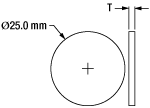




 Products Home
Products Home

















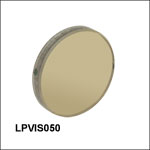
 Zoom
Zoom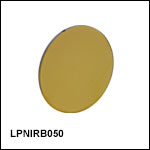
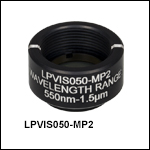
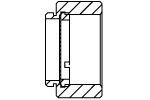
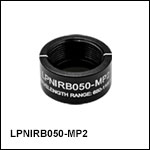
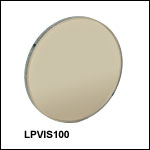
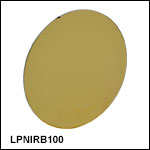

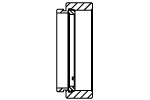
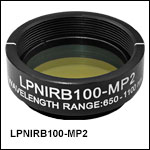
 Linear Film Polarizers
Linear Film Polarizers